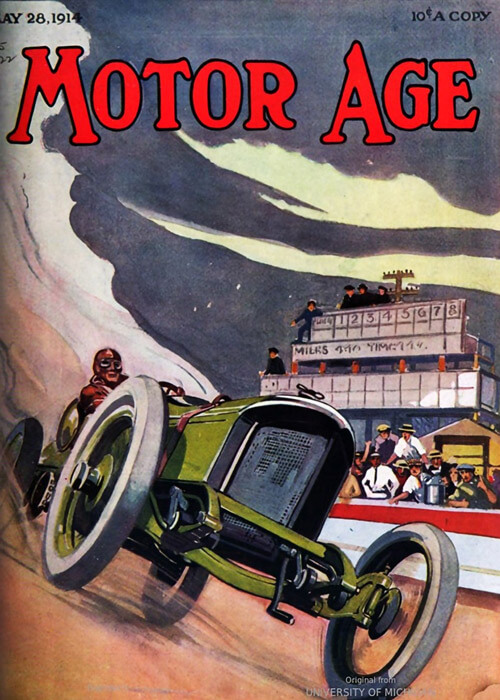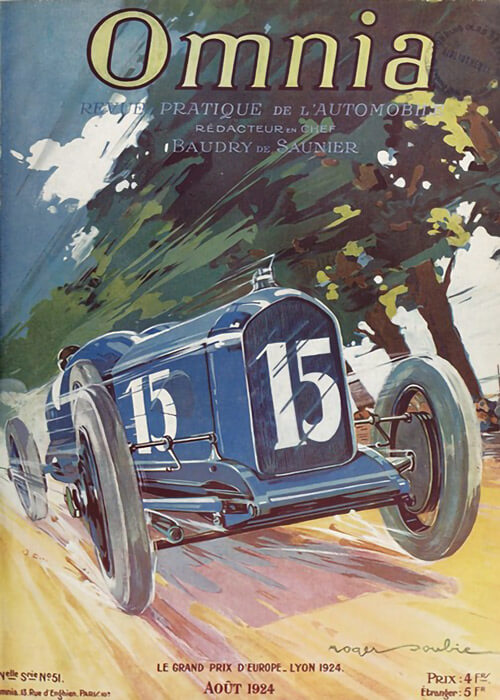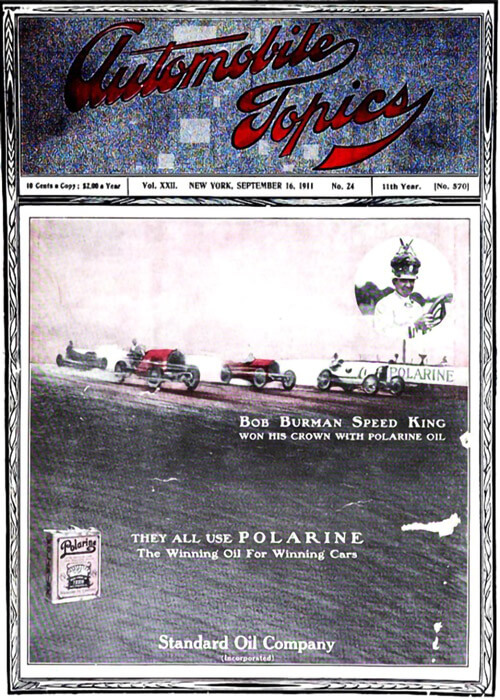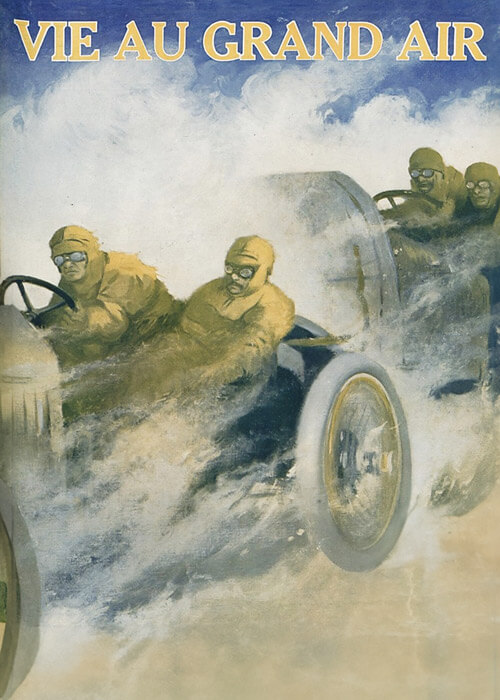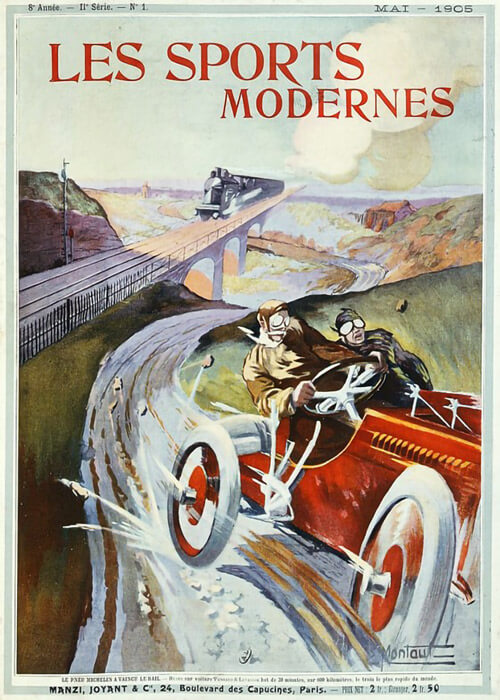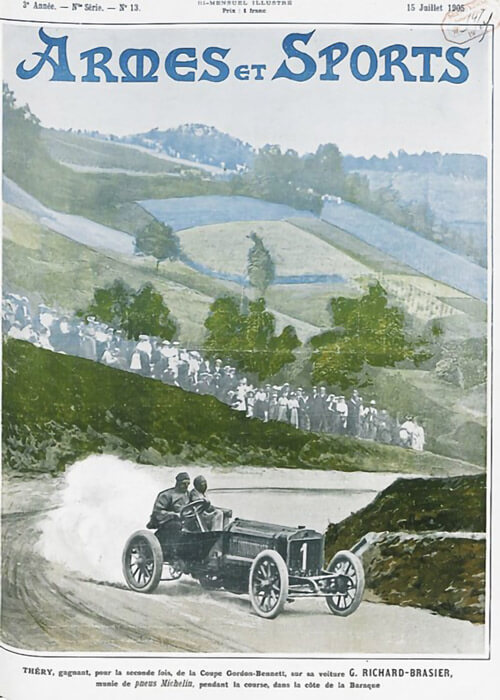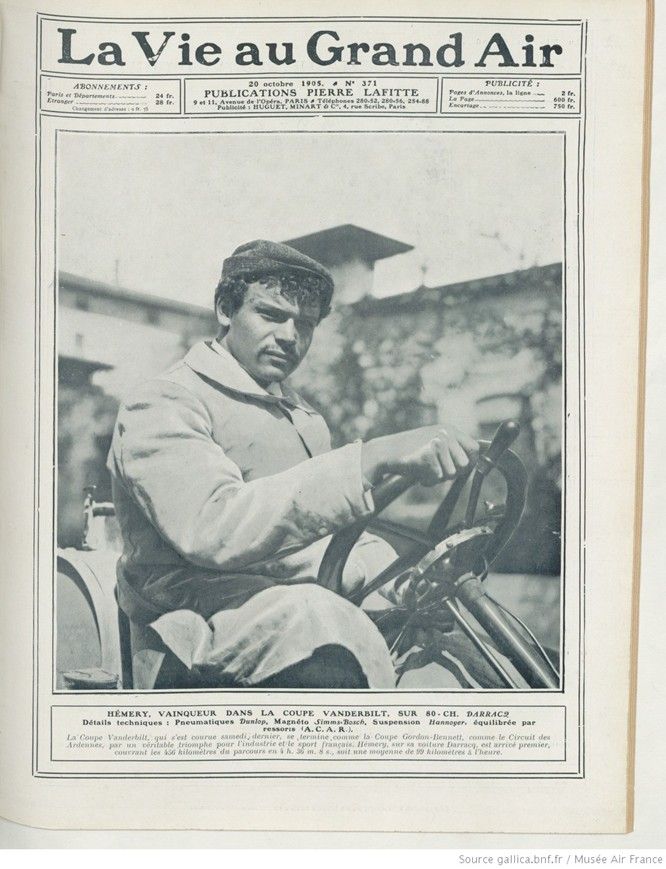
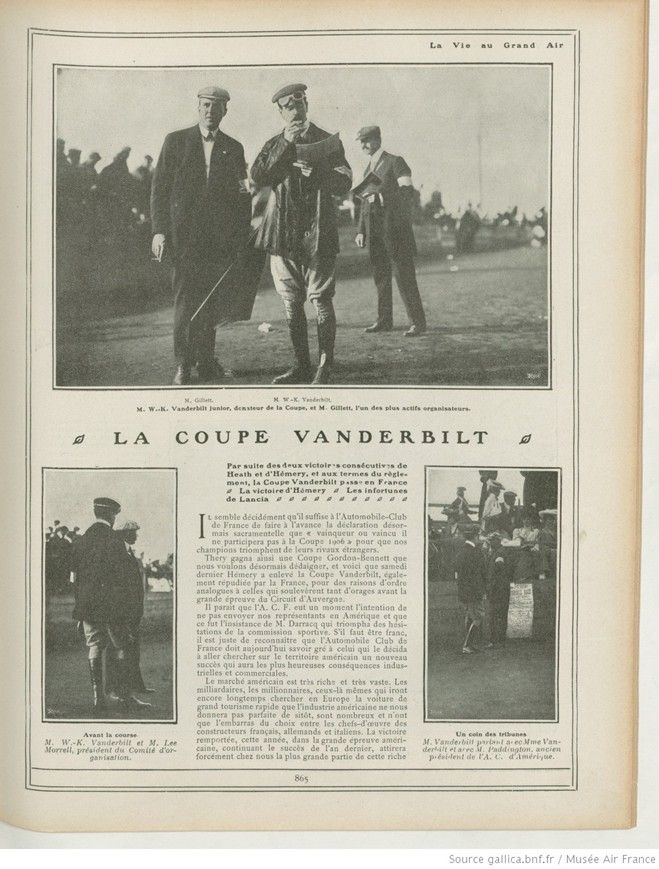
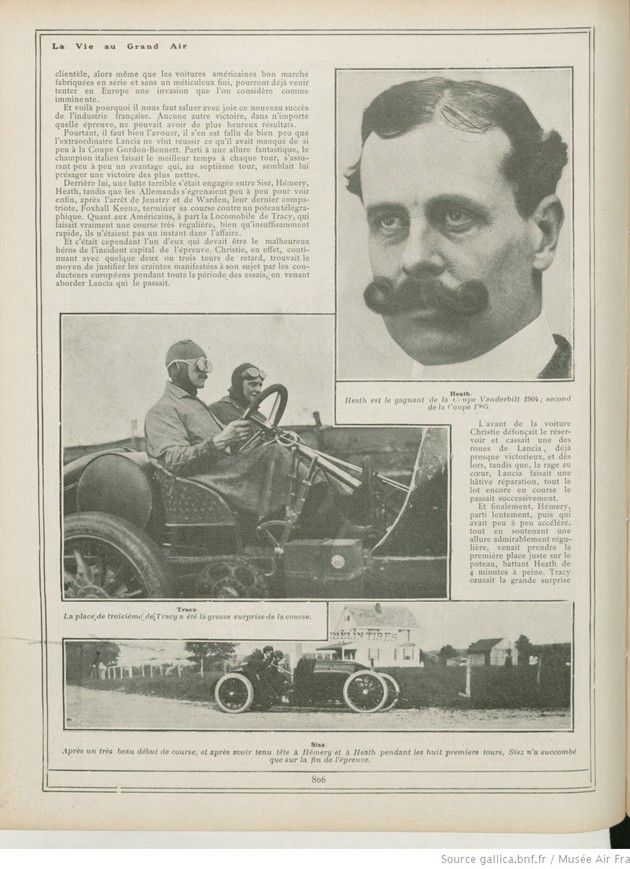
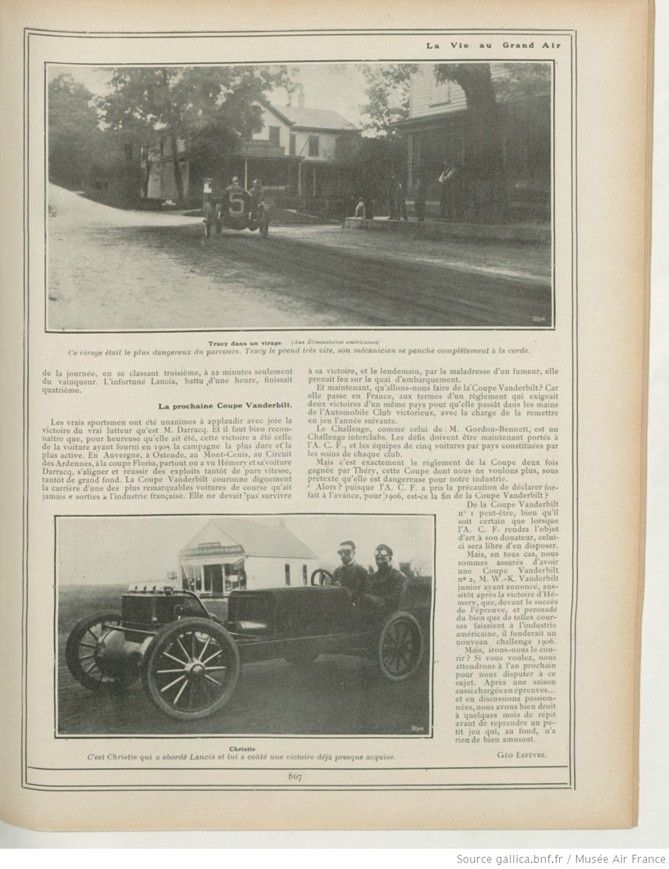
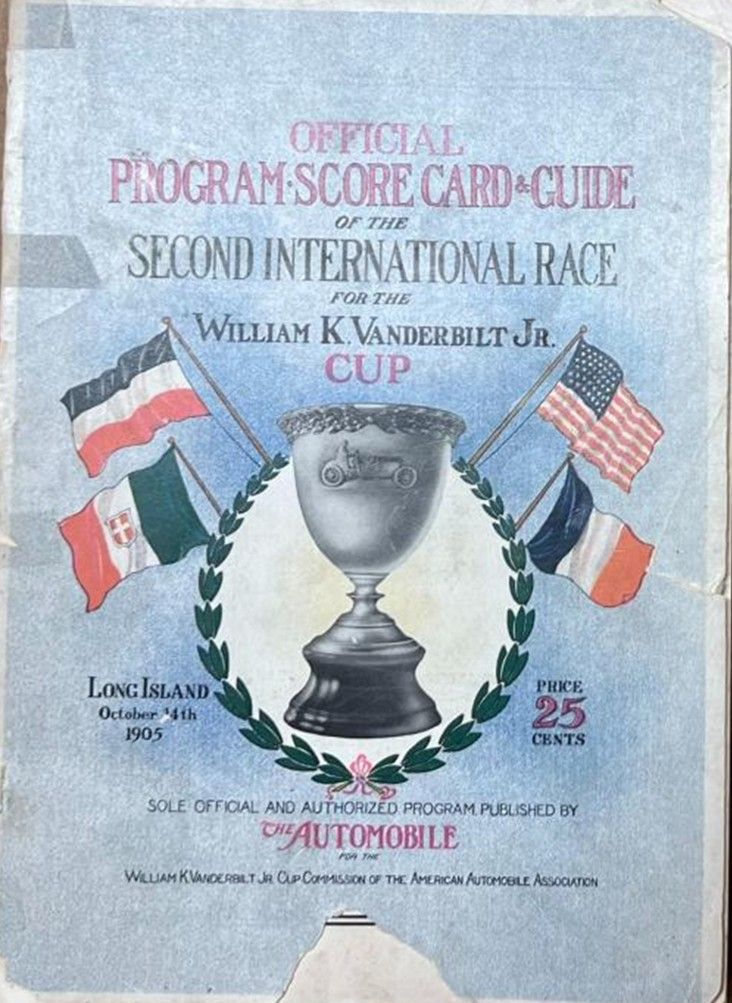
Texte et images avec l’authorisation de Bibliothèque national français, gallica.bnf.fr
compilé par motorracinghistory.com,
La Vie au Grand Air, Vol. 8, No. 371, 20 octobre 1905
La Coupe Vanderbilt
Par suite des deux victoires consécutives de Heath et d’Hémery, et aux termes du règlement, la Coupe Vanderbilt passe en France – La victoire d’Hémery – Les infortunes de Lancia
Il semble décidément qu’il suffise à l’Automobile-Club de France de faire à l’avance la déclaration désormais sacramentelle que « vainqueur ou vaincu il ne participera pas à la Coupe 1906 » pour que nos champions triomphent de leurs rivaux étrangers.
Thery gagna ainsi une Coupe Gordon-Bennett que nous voulons désormais dédaigner, et voici que samedi dernier Hémery a enlevé la Coupe Vanderbilt, également répudiée par la France, pour des raisons d’ordre analogues à celles qui soulevèrent tant d’orages avant la grande épreuve du Circuit d’Auvergne.
Il parait que l’A. C. F. eut un moment l’intention de ne pas envoyer nos représentants en Amérique et que ce fut l’insistance de M. Darracq qui triompha des hésitations de la commission sportive. S’il faut être franc, il est juste de reconnaître que l’Automobile Club de France doit aujourd’hui savoir gré à celui qui le décida à aller chercher sur le territoire américain un nouveau succès qui aura les plus heureuses conséquences industrielles et commerciales.
Le marché américain est très riche et très vaste. Les milliardaires, les millionnaires, ceux-là mêmes qui iront encore longtemps chercher en Europe la voiture de grand tourisme rapide que l’industrie américaine ne nous donnera pas parfaite de sitôt, sont nombreux et n’ont que l’embarras du choix entre les chefs-d’œuvre des constructeurs français, allemands et italiens. La victoire remportée, cette année, dans la grande épreuve américaine, continuant le succès de l’an dernier, attirera forcément chez nous la plus grande partie de cette riche clientèle, alors même que les voitures américaines bon marché fabriquées en série et sans un méticuleux fini, pourront déjà venir tenter en Europe une invasion que l’on considère comme imminente.
Et voilà pourquoi il nous faut saluer avec joie ce nouveau succès de l’industrie française. Aucune autre victoire, dans n’importe quelle épreuve, ne pouvait avoir de plus heureux résultats.
Pourtant, il faut bien l’avouer, il s’en est fallu de bien peu que l’extraordinaire Lancia ne vînt réussir ce qu’il avait manqué de si peu à la Coupe Gordon-Bennett. Parti à une allure fantastique, le champion italien faisait le meilleur temps à chaque tour, s’assurant peu à peu un avantage qui, au septième tour, semblait lui présager une victoire des plus nettes.
Derrière lui, une lutte terrible s’était engagée entre Sisz, Hémery, Heath, tandis que les Allemands s’égrenaient peu à peu pour voir enfin, après l’arrêt de Jenatzy et de Warden, leur dernier compatriote, Foxhall Keene, terminer sa course contre un poteau télégraphique. Quant aux Américains, à part la Locomobile de Tracy, qui faisait vraiment une course très régulière, bien qu’insuffisamment rapide, ils n’étaient pas un instant dans l’affaire.
Et c’était cependant l’un d’eux qui devait être le malheureux héros de l’incident capital de l’épreuve. Christie, en effet, continuant avec quelque deux ou trois tours de retard, trouvait le moyen de justifier les craintes manifestées à son sujet par les conducteurs européens pendant toute la période des essais, en venant aborder Lancia qui le passait.
L’avant de la voiture Christie défonçait le réservoir et cassait une des roues de Lancia, déjà presque victorieux, et dès lors, tandis que, la rage au cœur, Lancia faisait une hâtive réparation, tout le lot encore en course le passait successivement.
Et finalement, Hémery, parti lentement, puis qui avait peu à peu accéléré, tout en soutenant une allure admirablement régulière, venait prendre la première place juste sur le poteau, battant Heath de 4 minutes à peine. Tracy causait la grande surprise de la journée, en se classant troisième, à 22 minutes seulement du vainqueur. L’infortuné Lancia, battu d’une heure, finissait quatrième.
La prochaine Coupe Vanderbilt.
Les vrais sportsmen ont été unanimes à applaudir avec joie la victoire du vrai lutteur qu’est M. Darracq. Et il faut bien reconnaître que, pour heureuse qu’elle ait été, cette victoire a été celle de la voiture ayant fourni en 1905 la campagne la plus dure et la plus active. En Auvergne, à Ostende, au Mont-Cenis, au Circuit des Ardennes, à la coupe Florio, partout on a vu Hémery et sa voiture Darracq, s’aligner et réussir des exploits tantôt de pure vitesse, tantôt de grand fond. La Coupe Vanderbilt couronne dignement la carrière d’une des plus remarquables voitures de course ne qu’ait jamais « sorties » l’industrie française. Elle ne devait pas survivre à sa victoire, et le lendemain, par la maladresse d’un fumeur, elle prenait feu sur le quai d’embarquement.
Et maintenant, qu’allons-nous faire de la Coupe Vanderbilt ? Car elle passe en France, aux termes d’un règlement qui exigeait deux victoires d’un même pays pour qu’elle passât dans les mains de l’Automobile Club victorieux, avec la charge de la remettre en jeu l’année suivante.
Le Challenge, comme celui de M. Gordon-Bennett, est un Challenge interclubs. Les défis doivent être maintenant portés à l’A. C. F., et les équipes de cinq voitures par pays constituées par les soins de chaque club.
Mais c’est exactement le règlement de la Coupe deux fois gagnée par Théry, cette Coupe dont nous ne voulons plus, sous prétexte qu’elle est dangereuse pour notre industrie.
Alors ? puisque l’A. C. F. a pris la précaution de déclarer forfait à l’avance, pour 1906, est-ce la fin de la Coupe Vanderbilt ?
De la Coupe Vanderbilt n° 1 peut-être, bien qu’il soit certain que lorsque l’A. C. F. rendra l’objet d’art à son donateur, celui-ci sera libre d’en disposer.
Mais, en tous cas, nous sommes assurés d’avoir une Coupe Vanderbilt n° 2, M. W.-K. Vanderbilt junior ayant annoncé, aussitôt après la victoire d’Hémery, que, devant le succès de l’épreuve, et persuadé du bien que de telles courses faisaient à l’industrie américaine, il fonderait un nouveau challenge 1906.
Mais, irons-nous le courir ? Si vous voulez, nous attendrons à l’an prochain pour nous disputer à ce sujet. Après une saison aussi chargée en épreuves… et en discussions passionnées, nous avons bien droit à quelques mois de répit avant de reprendre un petit jeu qui, au fond, n’a rien de bien amusant. GÉO LEFÈVRE.
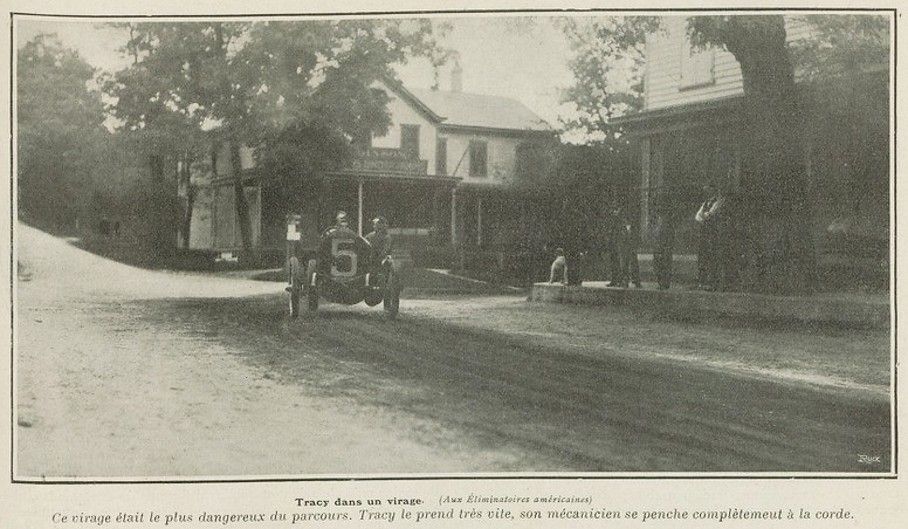
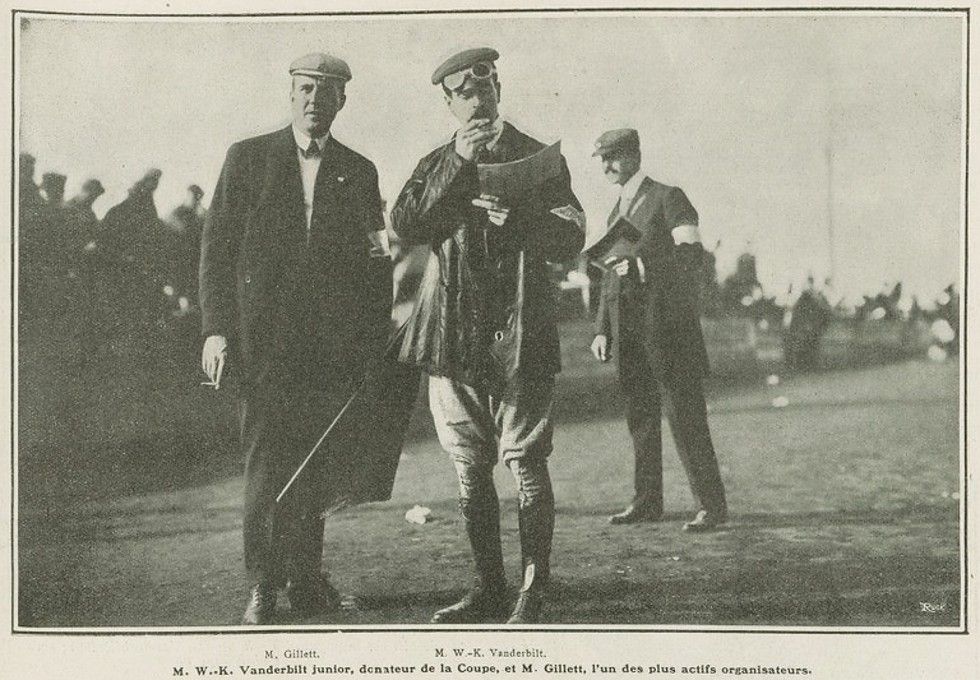
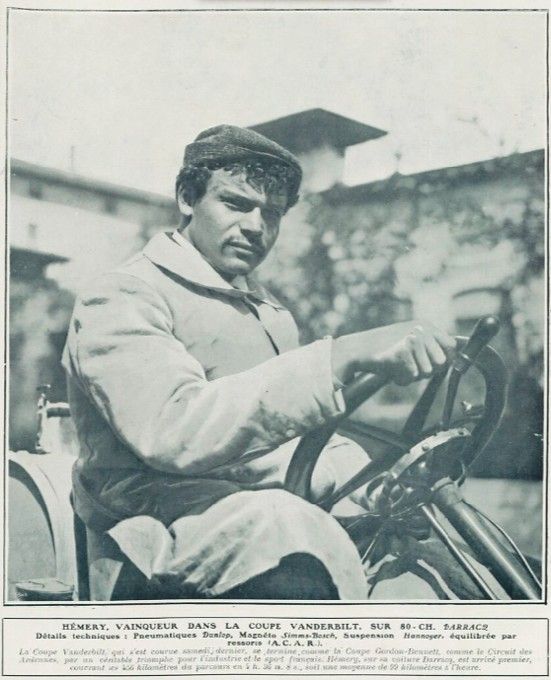
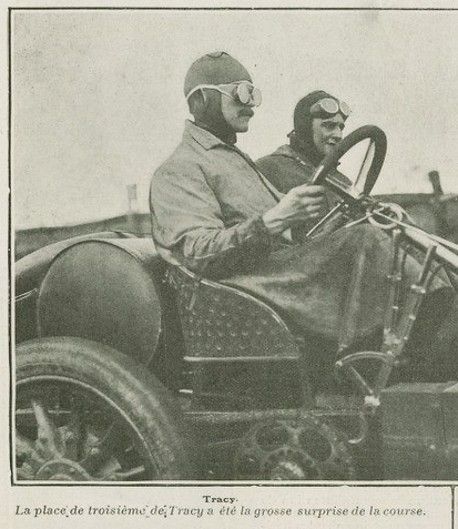
Translation by motorracinghistory.com, supported by DeepL.com
THE VANDERBILT CUP
Following the two consecutive victories of Heath and Hémery, and in accordance with the rules, the Vanderbilt Cup goes to France – Hémery’s victory – Lancia’s misfortunes
It definitely seems that all the Automobile-Club de France has to do is to make the now sacramentally obligatory declaration in advance that “winner or loser it will not take part in the 1906 Cup” for our champions to triumph over their foreign rivals.
Thery thus won a Gordon-Bennett Cup that we now want to disdain, and last Saturday Hémery won the Vanderbilt Cup, also repudiated by France, for reasons similar to those that caused so many storms before the big event on the Circuit d’Auvergne.
It seems that the A. C. F. had for a moment intended not to send our representatives to America and that it was the insistence of Mr. Darracq that triumphed over the hesitations of the sports commission. To be frank, it is fair to recognize that the Automobile Club de France must today be grateful to the person who decided to seek on American territory a new success that will have the most fortunate industrial and commercial consequences.
The American market is very rich and very large. The billionaires and millionaires, the very people who will continue to look to Europe for the fast touring car that American industry will not be able to provide us with any time soon, are numerous and are spoiled for choice between the masterpieces of French, German and Italian manufacturers. The victory won this year in the great American event, continuing last year’s success, will inevitably attract most of this wealthy clientele to us, even as cheap American cars manufactured in series and without a meticulous finish may already be coming to attempt an invasion in Europe that is considered imminent.
And that is why we must joyfully salute this new success of French industry. No other victory, in any event, could have had more fortunate results.
However, it must be admitted that the extraordinary Lancia came very close to repeating its Gordon Bennett Cup success. Setting off at a fantastic pace, the Italian champion set the fastest time on each lap, gradually building up an advantage which, on the seventh lap, seemed to presage a very clear victory.
Behind him, a terrible struggle had begun between Sisz, Hémery and Heath, while the Germans were gradually falling behind. Finally, after Jenatzy and Warden had retired, their last compatriot, Foxhall Keene, crashed into a telegraph pole. As for the Americans, apart from Tracy’s Locomobile, which ran a very consistent race, although not fast enough, they were not in the running for a moment.
And yet it was one of them who was to be the unfortunate hero of the crucial incident of the event. Christie, still some two or three laps behind, managed to justify the fears European drivers had expressed about him throughout the practice period, by coming up alongside the Lancia that had passed him.
The front of the Christie car smashed through the fuel tank and broke one of the wheels of the almost victorious Lancia, and from then on, while Lancia made a hasty repair in a rage, the entire group still in the race successively passed him.
And finally, Hémery, who had started slowly but then gradually picked up speed while maintaining an admirably steady pace, took first place just at the finish line, beating Heath by barely 4 minutes. Tracy caused the big surprise of the day, finishing third, just 22 minutes behind the winner. The unfortunate Lancia, beaten by an hour, finished fourth.
The next Vanderbilt Cup.
True sportsmen were unanimous in applauding with joy the victory of the true wrestler that is Mr. Darracq. And it must be recognized that, as happy as it was, this victory was that of the car that had provided the toughest and most active campaign in 1905. In Auvergne, Ostend, Mont-Cenis, the Circuit des Ardennes, the Florio Cup, everywhere Hémery and his Darracq car were seen lining up and achieving feats of pure speed and endurance. The Vanderbilt Cup was a fitting crowning glory for the career of one of the most remarkable racing cars ever produced by French industry. It was not to survive its victory, and the next day, through the clumsiness of a smoker, it caught fire on the embarkation quay.
And now, what are we going to do with the Vanderbilt Cup? Because it is going to France, under the terms of a regulation that required two victories by the same country for it to pass into the hands of the victorious Automobile Club, with the responsibility of putting it back into play the following year.
The Challenge, like that of Mr. Gordon-Bennett, is an interclub Challenge. The challenges must now be submitted to the A. C. F., and the teams of five cars per country must be formed by each club.
But this is exactly the regulation of the Cup twice won by Théry, this Cup that we no longer want, on the pretext that it is dangerous for our industry.
So? since the A. C. F. has taken the precaution of forfeiting in advance, for 1906, is this the end of the Vanderbilt Cup?
The Vanderbilt Cup No. 1 perhaps, although it is certain that when the A. C. F. returns the work of art to its donor, the latter will be free to dispose of it.
But, in any case, we are assured of having a Vanderbilt Cup No. 2, as Mr. W.-K. Vanderbilt Junior announced, immediately after Hémery’s victory, that, given the success of the event, and convinced of the good that such races did for American industry, he would found a new challenge in 1906.
But are we going to run it? If you like, we’ll wait until next year to argue about it. After a season so full of events… and passionate discussions, we are entitled to a few months‘ respite before resuming a little game which, after all, is not at all fun. GÉO LEFÈVRE.
